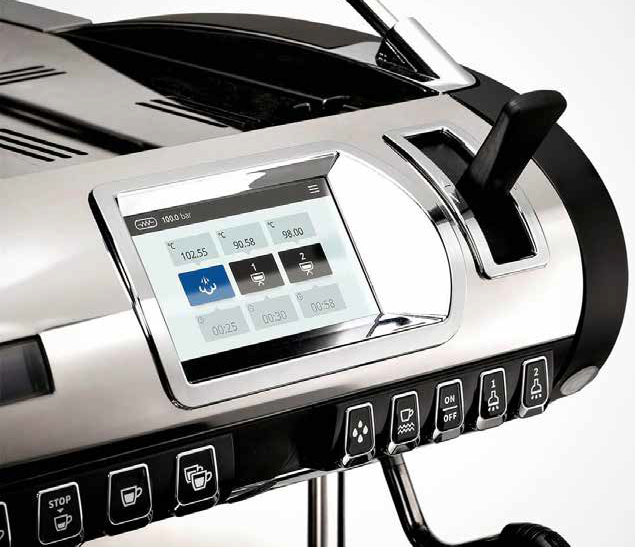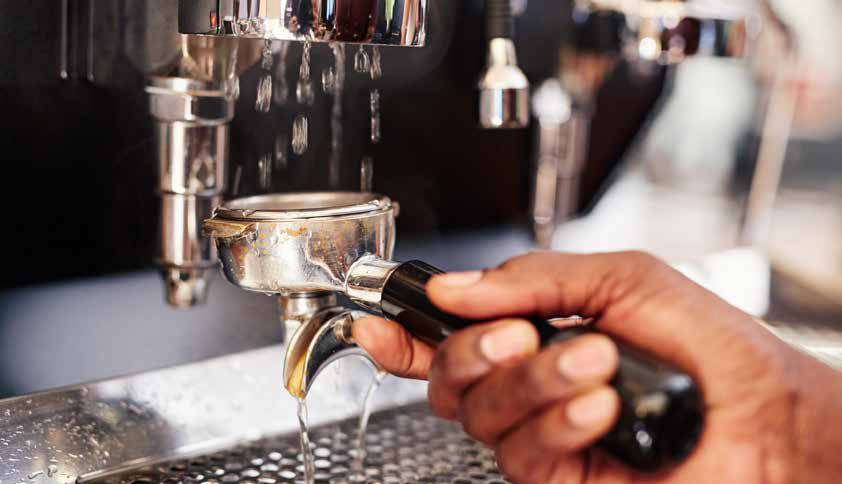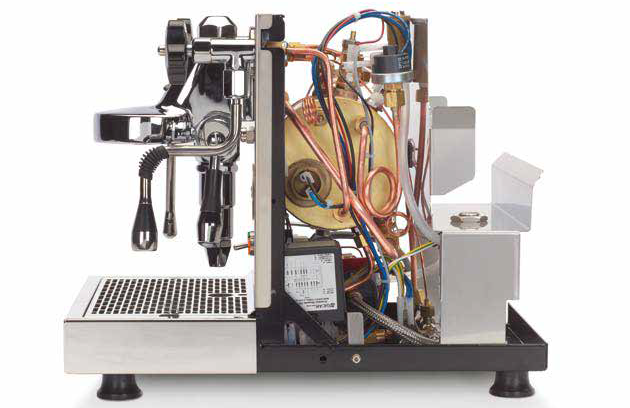An espresso machine can be complex, but at its core, it has a simple job: to provide hot water at a specific temperature and pump it through a bed of coffee at high pressure.
For a barista, how good an espresso machine is at achieving a specific temperature is one of the most important factors in choosing which espresso machine to use.
If the brewing water is too hot, it can extract burned, bitter flavors from the coffee. Too cold, on the other hand, and the coffee may end up tasting weak and sour.
The most important factor is that the temperature is consistent — after all, coffee is addictive, so most customers want to have the same drink each day.

However, being able to adjust the temperature for different coffees can also help a skilled barista to get the best flavor possible out of each bean.
How consistent the machine’s brewing temperature is, and how easy it is to adjust, depends on what method the machine uses to heat the water. The two main types found in commercial espresso machines are single boiler heat exchangers and multi-boiler systems.
Multi-boiler systems are much better at controlling the brewing temperature — but they usually cost more.
Because of their low price, on the other hand, single boiler heat exchanger machines are still popular. But is it worth spending the extra money on a multi-boiler machine?
In this article, we’ll explain the difference in how these technologies work, to help you decide which type of machine you will need for your specialty coffee shop.
Inside a heat exchanger machine
A heat exchanger machine (often abbreviated HX) is built around a single large boiler. This boiler provides steam for making milk drinks, hot water for tea, and heats the water used to brew coffee.

In this type of machine, the water for brewing coffee doesn’t come directly from the main boiler. Instead, the brewing water passes through a heat exchanger, which uses heat from the boiler to quickly heat the water.
The heat exchanger is a pipe that passes right through the middle of the boiler. Fresh cold water enters at the bottom and rapidly heats up because the pipe is surrounded by hot water and steam in the boiler. The heated water from the heat exchanger is then used to brew coffee.

The temperature inside the boiler of a heat exchanger machine is usually somewhere between 118 and 124 °C (244–255 °F) — much too hot for coffee brewing. The machine, therefore, has to take some of the heat out of the water before it reaches the coffee, to bring it to the desired temperature for coffee brewing, somewhere between 90 and 96 °C (195–205 °F).
To control the brewing temperature, most heat exchanger machines use a thermosyphon. This is a loop that connects the heat exchanger to the group head and keeps the group head at the right temperature for brewing.
How a thermosyphon works
A thermosyphon is a clever piece of engineering that maintains the right temperature in the group head. Understanding how it works can help to understand the limitations of this type of machine — but it’s not essential, so if you want to keep it simple, feel free to skip this section!

For more technically-minded readers, however, here’s how the thermosyphon works:
- The brew water in the heat exchanger gets very hot because it is surrounded by steam and hot water in the boiler. Hot water is less dense than cold water, so it rises.
- The very hot water from the heat exchanger reaches the group head. The group is made of metal, so it radiates heat, cooling the water down to brewing temperature (90–96 °C or 195–205 °F).
- The cooler water is denser than the hot water, so it sinks.
- The cooler water goes back into the heat exchanger where the cycle begins again.
This system means that while the machine is idle, the water in the thermosyphon is constantly circulating, keeping the group head at the right temperature.

Now let’s see what happens when you start brewing a shot:
- The pump turns on and pumps cold water into the machine.
- This pushes water towards the group, through both sides of the thermosyphon.
- The hot and cooler water mix together in the group head.
- The group head is already at the right temperature for brewing. The group head is a big block of metal, so when fresh water passes through it, it quickly reaches the same temperature as the group head.
The drawbacks of a heat exchanger
Because the heat exchanger machine only has one boiler, it is much cheaper to make than a multi-boiler machine. Even if the science behind how it works seems complicated, they are simple to build.

There are some disadvantages to a heat exchanger system. Firstly, the temperature is not as stable as a multi-boiler machine. If you use a lot of hot water for tea, or steam to make lattes, then the boiler temperature will drop, which can affect the brewing temperature.
When you brew espresso, the temperature also changes slightly during the shot. The group usually starts off hot, but then gets cooler and cooler as more cold water is pumped into the system.

In many heat exchanger machines, the brewing water starts off boiling — so the barista has to flush a bit of water out before brewing, to stabilize the temperature. This wastes water and wastes the electricity used to heat that water.
The group head also has to constantly radiate heat for the thermosyphon to work. This wastes even more energy.
Finally, it’s not usually possible to adjust the temperature in a heat exchanger machine. Even in machines where you can change the boiler temperature, it’s not always clear what effect that will have on the brewing temperature.
Heat exchangers are less energy efficient, and offer less control over the temperature, than multi-boiler machines.
Inside a multi-boiler machine
A multi-boiler machine uses separate boilers for brewing and for making steam. This allows more control over the brewing temperature.
Multi-boiler machines might have one boiler per group, like in the Black Eagle, or one boiler for all the brew groups together, like in the Linea Classic.

The brew boiler (1) can be heated to a precise brewing temperature, and the water used for brewing comes directly from that boiler. This means that the brewing temperature can be easily changed and very precisely controlled — in many machines, the temperature can be maintained within a tenth of a degree.
The steam and hot water come from a separate boiler (2), usually a larger boiler at the back of the machine. No matter how much steam you use, it doesn’t affect the temperature of the brewing boiler. This is essential if you want to make a lot of milk drinks.
If there are separate boilers for each group, you can even set different temperatures for each one. This can be useful if you want to use different brewing temperatures for different coffees.
Multi-boiler machines don’t rely on the group head cooling the brewing water down. The boiler, group, and pipework can all be insulated. This means they can be a lot more energy-efficient than single boiler heat exchanger machines.
The only real disadvantage is that with the extra boilers and heating elements needed, multi-boiler machines are usually more expensive.
Still searching for The One?
Contact our team for a free personalized consultation, and we will help you find what you’re looking for.
REQUEST FREE CONSULTATION


